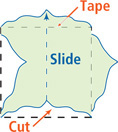Concept Byte: Creating Tessellations
Use With Lesson 9-7
ACTIVITY
The following activity shows the steps for making a creative tessellation, or repeating pattern of one or more shapes that fills a plane without leaving any gaps.
Activity
- Step 1 Draw a 1.5-in. square on a blank piece of paper and cut it out.
-
Step 2 Draw a curve with endpoints on one side.

-
Step 3 Cut along the curve you drew and slide the cutout piece to the opposite side of the square. Tape it in place.

- Step 4 Repeat this process using the other two opposite sides of the square.
-
Step 5 Rotate the resulting figure. What does the figure look like? Is it a penguin wearing a hat or a knight on horseback? Could it be a dog with floppy ears? Use your imagination and decorate your figure.

-
Step 6 Make a tessellation using your figure.

Exercises
Use the method described in the activity above to make a creative tessellation with each of the following types of polygons.
- a rectangle with length 3 in. and width 2 in.
- a parallelogram with 2-in. sides
- a regular hexagon with 1.5-in. sides
Table of Contents
- 6-1 The Polygon Angle-Sum Theorems
- 6-2 Properties of Parallelograms
- 6-3 Proving That a Quadrilateral Is a Parallelogram
- 6-4 Properties of Rhombuses, Rectangles, and Squares
- 6-5 Conditions for Rhombuses, Rectangles, and Squares
- 6-6 Trapezoids and Kites
- 6-7 Polygons in the Coordinate Plane
- 6-8 and 6-9 Coordinate Geometry and Coordinate Proofs




